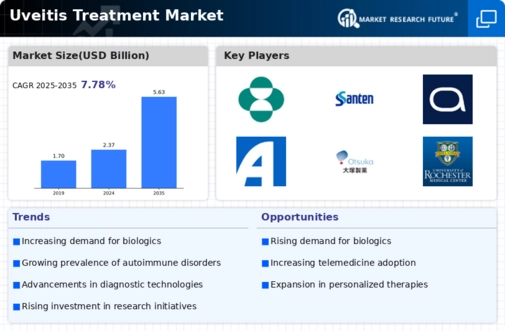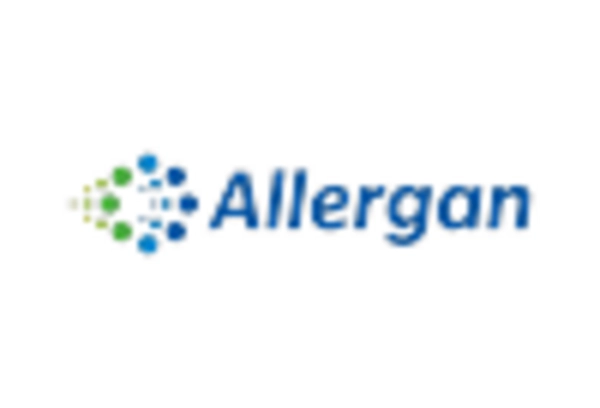Market Analysis
Uveitis Treatment Market (Global, 2023)
Introduction
The uveitis market is an important segment of the ophthalmological market, which addresses a number of inflammatory conditions affecting the uvea of the eye. Uveitis can lead to serious complications such as blindness, and effective and timely treatments are therefore required. The uveitis market is characterized by a wide range of treatment modalities, including corticosteroids, immunosuppressants and biological therapies, each of which is designed to address the different underlying causes and manifestations of uveitis. The market is also characterized by a lack of generic products, as well as a paucity of biosimilars. As awareness of the condition grows and as the treatment options available continue to evolve, the market is set for significant change. Moreover, the increasing prevalence of autoimmune diseases, the ageing of the population and the ongoing research into new therapies are expected to affect the market’s development. Moreover, the integration of digital health solutions and the implementation of precision medicine will further enhance patient outcomes and drive the market’s growth. This makes the uveitis market of particular interest to the entire health care industry.
PESTLE Analysis
- Political
- Uveitis market in 2023 is expected to be influenced by the various political factors such as the government policies towards eye care and research funding. In the United States, the National Eye Institute has received approximately $ 3.5 billion for research and development of eye diseases, which include uveitis. In addition, the implementation of the Affordable Care Act has led to increased access to health care services, thereby affecting the market.
- Economic
- The economic environment of the uveitis market is influenced by healthcare expenditure and the overall economic climate affecting patient spending. In 2023, the U.S. government is forecasting that healthcare expenditure will reach $4.3 billion, of which a significant portion will be directed toward the treatment of chronic diseases, including uveitis. In addition, the average annual out-of-pocket expenses for uveitis treatment is estimated at $1,200, which can have an effect on treatment availability and adherence.
- Social
- The social factors play a crucial role in the uveitis market, especially in terms of patient awareness and education. In 2023, it is expected that about 60% of uveitis patients will not know about their condition before they are diagnosed, which reflects the need for increased public health campaigns. The occurrence of uveitis is also high in the US, with an estimated prevalence of 38.5 per 100,000 people, indicating the need for social initiatives to increase early diagnosis and treatment.
- Technological
- The uveitis market is changing rapidly with the development of new diagnostic and therapeutic tools. By 2023, five new biological therapies had been introduced in the market, with a clinical efficacy of more than 70 per cent. In addition, the integration of telemedicine has made it easier for patients to access the specialists. There was a 25 per cent increase in virtual consultations for uveitis in 2023 compared to the previous year.
- Legal
- Legal factors affecting the uveitis treatment market include regulations and patents that govern the introduction of new therapies. In 2023, the FDA is expected to approve three new uveitis therapies, which will increase the treatment options for patients. Also, the patents on some uveitis treatments are expected to expire in 2023, with at least two major therapies losing their patent protection by the end of the year, which may increase competition and lower the price of the drugs.
- Environmental
- Uveitis market is increasingly influenced by environmental factors, especially in terms of the sustainability of the pharmaceutical production process. In 2023, it is estimated that the pharmaceutical industry will be responsible for about 10% of industrial water pollution. As a result, companies are being pushed to adopt greener practices. By 2025, at least 15% of uveitis treatment manufacturers will have committed to the goal of reducing the carbon footprint.
Porter's Five Forces
- Threat of New Entrants
- The barriers to entry in the Uveitis Treatment Market are moderate, owing to the substantial investments required for research and development, regulatory approvals, and clinical trials. Although the high return on investment may attract new players, the strong brand equity and distribution network of established companies may act as a barrier for new players.
- Bargaining Power of Suppliers
- The suppliers in the Uveitis Market generally have low bargaining power. The market is characterized by a large number of suppliers of raw materials and active pharmaceutical ingredients, which limits the influence of any one supplier. In addition, the existence of multiple alternatives makes it easy for manufacturers to switch suppliers.
- Bargaining Power of Buyers
- The uveitis treatment market is characterized by the medium bargaining power of the buyers, who are the health care institutions and the patients. While health care institutions can make their buying decisions on the basis of treatment efficiency and cost, patients have a limited number of treatment options, which gives manufacturers some leverage.
- Threat of Substitutes
- The threat of substitutes on the uveitis market is moderate. There are alternative treatments and therapies available for uveitis, such as corticosteroids and immunosuppressants. However, the effectiveness and side effects of these alternatives vary. Patients may therefore prefer to opt for the proven treatments. Nevertheless, ongoing research may introduce new alternatives.
- Competitive Rivalry
- Competition is high in the Uveitis Market. Several key players compete for market share. Several pharmaceutical companies, with their ongoing innovations and aggressive marketing strategies, contribute to the high level of competition. Competition is a continuous process, as companies try to differentiate their products on the basis of their efficacy, safety, and patient outcomes.
SWOT Analysis
Strengths
- Increasing prevalence of uveitis and related eye disorders driving demand for treatment options.
- Advancements in drug development and technology enhancing treatment efficacy.
- Strong pipeline of innovative therapies and biologics under development.
Weaknesses
- High cost of treatment and limited insurance coverage for certain therapies.
- Complexity of uveitis diagnosis and treatment may lead to mismanagement.
- Limited awareness and understanding of uveitis among healthcare providers.
Opportunities
- Growing investment in research and development for uveitis treatments.
- Potential for expansion into emerging markets with rising healthcare access.
- Collaboration opportunities between pharmaceutical companies and research institutions.
Threats
- Intense competition among pharmaceutical companies leading to price wars.
- Regulatory challenges and lengthy approval processes for new treatments.
- Potential side effects and safety concerns associated with new therapies.
Summary
Uveitis market to 2023 is expected to be a strong one, mainly driven by the growing prevalence of eye disorders and advancements in treatment technology. However, challenges such as high treatment costs and lack of awareness among health care professionals are expected to restrain market growth. Opportunities exist in the form of R&D and market expansion, while threats from competition and regulatory issues may impact the market. Strategic focus on innovation and collaboration is required to take advantage of these opportunities and overcome these challenges.


















Leave a Comment